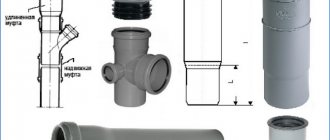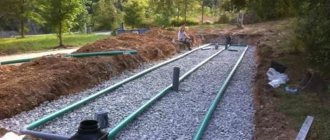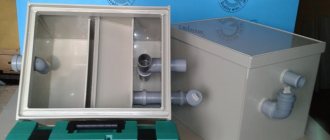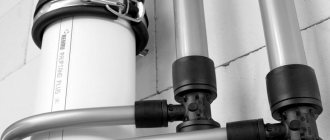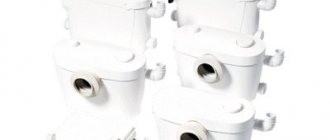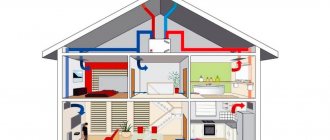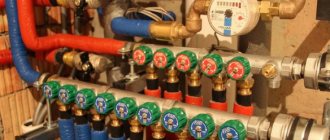Some owners know nothing at all about this element of the home’s sewer system. That is, neither about its existence, nor about its purpose, nor about the importance of the installation, where it is necessary. I think it makes sense to clarify this issue, to “paint over the white spot.”
Vacuum valve for sewerage
So, the sewer system must be created according to certain rules. These standards are not taken out of thin air - they are, one might say, “hard-won”, representing a kind of generalized experience of several generations, supplemented by scientific research and confirmation. And neglecting these requirements often leads to increased sewerage breakdown rates, and, perhaps, always to a sharp decrease in the comfort of living in a house where it is not equipped according to the rules.
But it also happens that some recommendations are difficult to implement in practice due to the specifics of the system. Then certain deviations are allowed, true, but with mandatory compensation of one kind or another. Such cases include the installation of a vacuum valve for sewerage.
Necessary information about the sewer drain pipe
The importance of using a vacuum valve will be difficult for an ignorant person to immediately understand if he does not have an idea of the general structure of the sewerage system. And in particular - about the need for ventilation and pressure equalization in pipes. Generally speaking, about the role of the vent pipe.
Let's take it step by step.
The sewage system must be ventilated...
In the sewerage system, all the main parameters are closely interconnected. This refers to the diameters of laid pipes in various areas, from plumbing fixtures to a collector or septic tank (cesspool), the angle of inclination to the horizontal at which they are installed, the speed of movement of wastewater and the degree of filling of pipe channels. There are special methods for calculating these characteristics, and with proper selection and installation, the system should operate without failures.
The optimal slope is designed to ensure that the speed of movement of the wastewater at which the water almost completely transfers all contaminants. And at the same time, the pipe is not filled completely, but only to 0.5÷0.7 of the height of its cavity. In the upper part of the channel, air and gases that always accompany any sewer move freely, of course, a very unpleasant “aroma”.
Sewer pipes are laid with a certain slope i (depending on their diameter Dn), so that the optimal speed V of fluid movement and the required filling level of the pipe cavity are maintained inside.
We will not dwell on these aspects in more detail - they are already covered on the pages of our portal.
Why is the correct slope of sewer pipes so important?
Just so that the sewage system fully copes with its direct tasks. By the way, an excessive slope of sewer pipes is no less harmful to the system than an insufficient one. More details about this, with justifications and calculations, can be found in a separate publication on our portal.
So, if the sewer system is designed and installed correctly, the air channel in it always remains free. It plays the role of ventilation - through it air and gases must be discharged into the atmosphere. Moreover, in sewer pipes and chambers, due to the saturation of wastewater with organic waste, the processes of fermentation and decay do not stop. And this is always accompanied by the release of a considerable amount of gases, many of which, by the way, are very unsafe both from the point of view of toxicity and from the point of view of fire safety. That is, their timely withdrawal must be provided for.
This is precisely why ventilation outlets of pipes are provided to the outside. It is these ventilation risers that are called fan pipes.
Various options for the location of the drain pipe
For example, very often they are equipped with septic tank chambers or cesspools (position 4 in the figure). But if these local treatment facilities are located near the house, then sewer odors can greatly spoil the cozy atmosphere in the yard. Therefore, they usually try to place the head of such a pipe higher so that the “aromas” are immediately picked up and carried away by the wind. This could simply be some kind of vertical ventilation outlet, raised to a certain height, if the specifics of the site allow (item 3)
The most common option, especially when building several levels (floors), is to create a vertical riser (item 1), to which drainage sections from plumbing fixtures are connected. Above the highest high point of connection of the branch section, this riser itself turns into a drain pipe, passes through the roof covering and ends at the cap on the roof. This option can be considered the most reliable, since it fully copes with all absolutely the tasks of a fan pipe (one such important function will be discussed below).
Some owners, not wanting to organize the passage of a vent riser through the attic floor and roof, act as shown in the diagram - pos. 2. That is, the ventilation pipe is inserted into the area where it is laid horizontally outside the house, and then it rises vertically along the wall and ends above the eaves of the roof.
Of course, when bringing the vent pipe outside, certain rules must be observed based on its location relative to other objects:
- Wherever the pipe is located, its head should not be closer than four meters from opening windows or balconies.
- The cut of the vent pipe cannot be closer than 200 mm to the roof surface on pitched roofs or on flat unused ones.
- It cannot be closer than 100 from the edge of the prefabricated ventilation shaft.
- If the flat roof is in use, then the height of the drain pipe above it must be at least three meters. And this necessarily presupposes the presence of stretch marks.
- Deflectors or wind vanes are never put on the fan pipe.
Possible effect of water seal failure
Sometimes it can be very difficult to comply with all these requirements, which makes owners think about the question: is it possible to do without a vent pipe, that is, without ventilation. Limiting yourself, for example, to the growth of a small “fungus” in the area of the septic tank, and in the house - leaving the riser or wiring unventilated.
In principle, it is possible, although not advisable. But now is the time to remember the second important function of the fan pipe. We are talking about equalizing the pressure in the system.
It was already mentioned above that gases with a very unpleasant aroma are always “walking” in the sewer pipe. Why don’t we feel them with a properly assembled system?
Yes, simply because any plumbing fixtures connected directly to sewer pipes are equipped with a water seal. Or, as it is more often called, a siphon.
Siphons in plumbing fixtures connected to sewer pipes: 1 - toilet with rear connection; 2 - toilet with bottom connection; 3 - bath or shower tray; 4 and 5 - sinks of washbasins or kitchen sinks; 6 - ladder on the floor.
The diagram above clearly shows the principle of siphon design for various plumbing fixtures. Pay attention to the water level in the curved lower part of this valve - in a “quiet” state it corresponds to the level of overflow into the sewer pipe extending from the device. The design is thought out in such a way that the air from the sewer cannot overcome this water barrier - the smell does not enter the room.
The throughput of siphons is always made slightly lower than that of the pipes to which they are connected:
- For example, both the cross-section of the outlet pipe of the flush tank and the cross-section of the siphon in the toilet usually correspond to a maximum diameter of 70 mm. Whereas the toilet is always connected to a pipe with a diameter of 110 m.
— The cross-section of the sink or bathtub siphon tubes is usually similar to a pipe with a diameter of 30÷40 mm, and the connection is made to a 50 mm one.
Why was it designed this way in the first place? For reasons that even with the maximum output of water through the siphon (flushing a full toilet tank or opening the drain plug in a fully filled bathroom), the flow of escaping water in no case overflows the sewer pipe. That is, in any case, the air space that we have already discussed above should remain in the pipe.
Siphon for kitchen sink. Please note that the diameter of the tube coming from the sink drain is 32 mm, coming from the siphon is 40 mm, and it will connect to a 50 mm pipe. That is, overflowing a sewer pipe under normal conditions is impossible.
Why is it dangerous, overflow? It would seem like a few minutes - and still the water will disappear completely. Just think, there will be no ventilation for a short time...
That's not the point - the danger here is of a completely different kind.
If water (wastewater) upon exiting fills the entire cavity of the pipe, without an air gap, then it begins to act like a piston during movement. That is, leaving behind an area of low pressure - rarefaction. And this vacuum can become so great that it “takes with it” the water that should remain in the siphon. Or it will “suck” water from the water seal of another plumbing fixture connected to the same sewer pipe. There is not so much water in the siphons, and excessive efforts are not required to move it from its place and draw it into the pipe.
This effect is commonly referred to as siphon stalling. But no matter what it is called, the consequences of such a phenomenon are always the same. Namely, the water seal does not work. There is not the required amount of water to block the passage of gases, and an unpleasant odor from the sewer begins to penetrate into the room.
But how can a siphon break if, as we have seen, strong vacuums should not occur in the pipe - its diameter is always larger than the diameter of the plumbing fixture drain? Yes, this is true if we are talking about one device. But several devices are most often connected to one outlet pipe, and even more so to one riser. Moreover, in the case of a common riser, the number of connection points can be quite significant.
Thus, there is always the possibility that at some point several drains will be involved simultaneously. In this case, the total flow of wastewater collected from various points may temporarily exceed the throughput capacity of the pipe, and it will be filled to capacity. That is, the same “piston” will work, breaking the water seals.
Let's look at the diagram. It just shows a toilet as an example, but the “mechanism” for breaking the shutter is the same for all other plumbing fixtures.
Too large a volume of wastewater passing through the pipe (riser) at a time can create a zone of strong rarefaction of air behind it. And this vacuum can empty the siphons of connected plumbing fixtures - literally suck the water out of them.
But nothing like this will happen if such an overflow occurs below the connection point of the waste pipe - due to the openness to the atmosphere, rarefaction simply will not arise - it is compensated by the influx of air from the outside.
Let's look at the same diagram, but with a slight change.
A small change in the circuit - and you no longer have to worry about the water seal breaking.
Almost the same, but the changes are that a vertical drain pipe with access to the street is connected to the sewer pipe above our conventional “toilet bowl”. Now you don’t have to be afraid of the water seal breaking – the “deficit” of pressure in the vacuum zone will be immediately covered by the flow of air through it. That is, the pressure will equalize.
It would seem like a ready-made solution to the problem. But it was not there. Is it possible to install a drain pipe for every “problem” plumbing fixture? No, of course, it will be extremely difficult, and very inconvenient, costly, etc.
Further, even if the vertical common riser has a drain outlet, is there a guarantee that an overflow will not occur in the outlet area to which, for example, a bathtub, washbasin and washing machine drain hose are connected? And here, too, the possibility of such an unpleasant incident remains. Moreover, over time, sewer pipes can gradually become overgrown with sediment, that is, slightly decrease in diameter. In addition, the hydraulic strain of the pipes gradually increases due to interference adhering to the walls. That is, the wastewater does not flow out as quickly, and the risk of the formation of vacuum zones may increase.
This means that some compact device could help, which, on the one hand, would prevent unpleasant odors from entering the premises from the sewerage system. On the other hand, it would prevent the creation of vacuum zones during the massive release of wastewater, that is, it would ensure equalization of pressure.
Such a device exists. This is exactly the vacuum valve that is the topic of our consideration.
Installing a vacuum valve on the sewer allows, in some cases, to do without a drain pipe.
In fact, we have already quietly figured out the main purpose of this valve. It is difficult to add anything on this issue. Therefore, you can go straight to the consideration of the design of the aerator (the second name for such a device) and the basic principles of its installation.
When an adaptation is needed
The first signal about the need for an air valve is the appearance of extraneous noise in the system or the spread of unpleasant odors. Any deviations from normal functioning are immediate clues that there are problems with the sewer system. Installation of a vacuum valve is necessary to compensate for pressure.
With the help of the device, not only the problem of replacing the ventilation riser is solved, it helps in the following cases:
- impossibility of installing a drain pipe (riser);
- the need to reduce heat loss through ventilation;
- improving functionality and direct sewerage operation;
- protection against failure of fan elements.
How does a vacuum valve work?
It is already clear from the purpose of this device that it must remain closed when there is excess pressure in the sewer pipe or when it is equal to atmospheric pressure. But if a vacuum occurs in the pipe, the valve mechanism must ensure the opening of the passage for air to enter from the outside.
The principle is easily implemented with the “involvement” of ordinary gravitational forces. The diagram below shows the structure of one of the aerator models. Despite possible differences in the design of valves from different manufacturers, the principle remains virtually unchanged.
An example of a device and a demonstration of the principle of operation of a vacuum valve for sewage.
The entire valve mechanism is assembled in a polymer housing (item 1). The device itself implies only a horizontal arrangement, so in its lower part one or another device must be provided for a sealed connection with the sewer pipe. In the example shown, this is an elastic cuff (item 2) for inserting the aerator into a socket or even just into a cut pipe. There may be a connecting unit in the form of a standard sewer pipe socket or other options. But this installation is always simple, reliable and understandable.
Air can enter the aerator through the intake grille or slot-like openings (item 3). They are located at the bottom or on the side of the valve "head", but outside air will almost always be applied to the valve diaphragm from below.
This is very easy to explain. The valve flap (pos. 5) is located in the seat assigned to it (pos. 4) and fits tightly to its edges with an elastic cuff (membrane), preventing air from passing from the pipe into the room. And the fit is ensured by the banal force of gravity of this damper. That is, even if the atmospheric and established pressures in the pipe (riser) are equal, the valve will be closed. This can also be facilitated by some excess pressure in the pipe, since gas formation in the sewer almost never stops. That is, the valve will thereby be pressed even more against the seat (in the diagram it is the left fragment).
But if, for one reason or another, even a slight vacuum is created in the pipe, atmospheric pressure will overcome gravity and lift the valve above the seat. As they say, “nature abhors a vacuum,” and the outside air will rush into the pipe, equalizing the pressure and preventing the siphons from breaking.
To prevent the damper from warping, it may have special guides (item 6). However, many models can do without them - centering is done due to the cylindrical shape of the valve assembly.
Aerator for 110 mm pipe - model with two valve heads. One of them has been disassembled to demonstrate its simple device.
Out of pure curiosity, you can “disassemble” several more vacuum valves of various models. But we still won’t find any fundamental differences there.
The differences in the design of different valve models are not fundamental.
By the way, since the device is being considered, you can immediately draw the readers’ attention to the “Achilles heel” of any valve. This, of course, is the membrane itself, or more precisely, the area of it that is pressed by gravity against the valve seat.
And here we are not talking about wear (if it exists, it is very unnoticeable), but about other obstacles that can prevent the sash from sealing:
- Over time, dust can accumulate on the valve seat or on the membrane itself, which can turn into hard lumps of dirt that prevent the valve from sealing tightly. Often the owners are notified of this by the “aroma” of sewerage entering the premises. The first thing to do when such a “bell” comes up is to check the cleanliness of the membrane and its fit, and carefully clean the assembly from contaminants.
- The second conclusion is that the vacuum valve must be installed only in a heated room of the house. Otherwise, with the onset of cold weather, drops of condensate may freeze on the seat or on the membrane, and the valve mechanism will not fit properly. And in general, too large temperature changes do not benefit the rubber membrane - it begins to “tan” in the cold, losing the necessary elasticity.
Otherwise, the mechanism is extremely simple, and it is difficult to come up with any circumstances that would lead to a breakdown of the vacuum valve.
Types of aerators
There are mechanical, electric and petrol tools. How to choose an aerator? Most gardeners are guided by the surface area of their lawn. If hand tools are suitable for small areas, then it is more advisable to aerate a large lawn using electric or gasoline machines.
Aerators for small areas (manual, foot, mechanical)
- metal forks
- studded sandals
- rake
- mechanical roller with spikes
Pitchfork. Using an ordinary garden fork, you can aerate a small lawn. The lawn should be pierced approximately half the depth of the tool. A puncture of 7–13 cm will be most optimal. It is not recommended to make frequent holes; 10–15 cm between rows will be enough.
Sandals with spikes are suitable for aerating a small lawn. The plastic or metal sole is secured to the shoe using several straps. The sole of the foot lawn aerator is equipped with 15 - 20 spikes, 3-5 cm in length. It is necessary to carefully secure the sandals to your shoes and walk in them on the grass. Steps should not be taken infrequently, approximately 20–30 cm each. To make walking easier, it is recommended to raise the sole of the foot parallel to the ground. A good exercise to improve your health!
A rake can also be used for aeration. It is inconvenient to make punctures with them, but by scraping along the surface of the earth, it loosens, which helps to aerate the soil. They are made from high-strength steels and equipped with thin, long teeth. A rake allows you to remove dry leaves, grass clippings and weed roots. Use the rake only on short-cut grass!
A mechanical aerator is a heavy iron roller with sharp spikes attached to its surface. Under the influence of the weight of the roller, the spikes penetrate the soil, loosening it. The disadvantage of a mechanical lawn aerator is that its use requires physical strength and considerable dexterity.
Aerators for treating large areas (electric and petrol)
These tools are quite expensive, so you should choose them responsibly
When choosing a tool, you should pay attention to the following features:
- Engine power. If the lawn area is large, then choose an aerator with high engine power. Such machines have an increased engine life, which allows the engine to operate longer than usual.
- Width of working surface. The wider the working surface of the aerator, the larger the area it can process in one pass.
- Machine body. Plastic is lightweight, but metal is much more durable.
- Container for collecting grass. It will be needed if the lawn area is large.
- Types of knives. Aerators have long metal spokes that pierce the soil cover. Scarifiers have special knives that remove withered grass and weeds.
For large areas of lawn, it is recommended to use electric or gasoline lawn aerators. Some models are multifunctional and equipped with additional sets of attachments, so scarification and aeration are available to them. Such universal machines perform several functions:
- make punctures (aeration) or cuts (scarification) in the soil
- remove caked grass residues
- collect the removed grass stems into a special container
- loosen the soil using an additional attachment.
An electric aerator is convenient if the length of the cord allows you to treat the entire lawn area.
Electric aerator/scarifier
The gasoline device can be effectively used over a large area because it operates autonomously.
Gasoline aerator
Which valve should I buy?
The question is difficult in the sense that there are no obvious “favorites” or “promoted” models. But at the same time, there is a very serious range of prices. And on top of that, there are no clear selection criteria, except, perhaps, the diameter of the pipe on which the valve is mounted, the dimensions if the space for its installation is limited, and the most convenient method of connecting to the pipe.
The drain pipes from the shower stall and washbasin converge at one point. To protect this unit from the siphon breaking, it was decided to install an aerator on a 50 mm pipe. In this case, of course, the dimensions of the device are important.
Moreover, if you “browse” through online stores of plumbing equipment, you will see that often no parameters other than diameter and dimensions are indicated at all. Sometimes you can see air throughput (liters per second), but that's probably all.
Of course, you should assume that more well-known manufacturers of plumbing products and valves will offer the most durable and reliable valve. But you can find a lot of examples where the most uncomplicated and inexpensive domestically produced aerators serve for decades and continue to serve.
Therefore, this is just a brief overview of the models offered for sale and their prices, but without any recommendations in favor of this or that product.
| Illustration | Short description | Approximate cost, rub. |
| "MkAlpine HC 50-50" - products of a company from the British Isles." Polypropylene. Model for pipe ø50 mm. Fits in a standard bell. Capacity – 3 l/s. | 850 rub. | |
| Model “MkAlpine” for DN110 mm pipe. Polypropylene. | 2500 rub. | |
| "HL900NECO" Austrian. Available in three versions - for pipes DN50, DN70 and DN110 mm. Polypropylene. Mesh on the side surface of the case. The flow capacity of the DN110 valve is 37 l/s. Thermally insulated housing walls. | For model DN110 – 2800 rub. | |
| Air valve “Wavin Optima Mini vent” from the famous Dutch company. Compact models for installation on sewer pipes with a diameter of 30, 40 and 50 mm. Polyvinyl chloride. Capacity – 7.5 l/s. Installation - in a standard socket. | 3600 rub. | |
| The Finnish product is the HTL vacuum valve. Manufactured for 110 mm, equipped with adapters for 50 and 70 mm. Polypropylene. | 4700 rub. | |
| Valve of the German brand "Ostendorf" made in Russia. Diameter – 110 mm. Polypropylene. | 1900 rub. | |
| Vacuum valve made in Russia. Diameter – 110 mm. | 190 rub. | |
| Valve made in Russia. Polypropylene. Diameter – 110 mm. | 240 rub. |
Probably, this is already enough to understand how “dancing” the prices for such products are. Moreover, with approximately equal characteristics, materials of manufacture, etc. So the author of this article does not take responsibility for recommending certain models - everything is too unobvious.
True, they can, but why do some DN110 aerators have one common head, while others have two small ones?
There is no special secret here. It’s just that the manufacturer produces models for both 50 mm and 110 mm pipes. And it is technologically easier for him to combine two smaller valve heads in one body to obtain an aerator for a larger diameter. But this does not particularly affect the operation of the device itself. Except that you have to take care of two membranes. But if one fails, it will cost less to replace than one large one.
Where and how to install the vacuum valve
We should start, of course, with the installation sites. But they should already be generally understandable – based on the valve’s tasks.
Nevertheless, let’s list:
- The classic installation location is the “crowning” of the riser, which for some reason cannot be made ventilated, that is, through the roof. Installation is carried out at the highest point.
Mandatory installation - at the top point of the riser, which will not be discharged to the street. Not a plug, but a vacuum valve!
- On a horizontal outlet section, if several plumbing fixtures are connected to it, then there is a possibility of the water seal breaking during a massive discharge of water.
In this case, it is advisable to place the valve at the farthest point of the horizontal section, so that it is located above the highest siphon on this branch.
- At the point of convergence of drain pipes from several plumbing fixtures, if their one-time total discharge at some point may exceed the capacity of the common pipe. Such an example was shown above in more than one of the illustrations.
There is no riser in this house at all, which means you need to install a vacuum valve at the highest point of the largest pipe. And, perhaps, you cannot do without valves on long horizontal sections.
- A one-story house may not have a riser at all. That is, horizontal outlet sections of 50 mm converge to the toilet, glued to a 110 mm pipe, and from there the pipe immediately descends and releases outwards, towards the septic tank or collector. This means that a vacuum valve would also come in handy in the area where small pipes are inserted into large pipes, in case of a massive discharge of water.
- Sometimes the circumstances themselves begin to “dictate” to the home owner where it is advisable to install a vacuum valve. For example, sewer pipes are probably overgrown, their internal diameter has decreased, and it would seem that the normal discharge of water still leads to the failure of the siphon. If it is not yet possible to completely change the entire pipe section, installing an aerator will save you.
Apparently, the owners were fed up with the frequent breakdown of the siphon due to poor permeability of the old cast iron pipe.
And they solved the problem by installing an aerator. Wherever the vacuum valve is installed, it is mandatory to ensure a free flow of air to the place of its installation. This means that it should not be a locked cabinet or a tightly closed, unventilated room. The volume of air entrained by water is very considerable - approximately 25 times greater.
In addition, it is necessary to consider easy access to the valve for checking, cleaning or other maintenance.
The position of the vacuum valve, as already mentioned, is exclusively vertical, without options.
It is advisable to protect the valve from splashing. This is achieved by placing it at a height of approximately 250÷350 from the horizontal pipe.
Options for inserting valves into different sections of pipes
Well, the installation of the valve itself probably doesn’t make sense to describe in detail. Anyone who has at least once seriously engaged in assembling sewer lines on their own can cope with the task without difficulty. The main thing is to understand the type of connection, do not forget to put the cuffs in the sockets. Switching to old cast iron pipes always causes a little more fuss - but here everything can be solved.
That is, the installation itself does not hide any serious features or differences from the assembly of other sewer units.
Device
The presence of drain risers in the sewer system of multi-apartment residential buildings is mandatory and is regulated by current government documents and building regulations. As a rule, sewer ventilation risers are made straight, due to the fact that the processes occurring there are gravity, not forced, and it is necessary to minimize the number of outlets and various narrowings for the most free passage of air flows.
Sewage systems in individual houses do not have such volumes of wastewater as in multi-apartment residential buildings, therefore the requirements for the installation of drain risers are less complex and allow for significant deviations for the sake of practicality and minimizing construction costs.
Fan riser installation
The sewer pipe is basically the upper continuation of the sewer riser, so it must end at the roof of the building. A standard deflector must be mounted at the end of the pipe, so that the distance from the surface of the roof ridge is 30 centimeters higher. It is not recommended to install sewer ventilation on the façade of the building.
Important! You cannot install the outlet of the sewer riser in the attic of the building or near windows and near balconies.
To install a fan riser, you can use pipelines made of any materials. Thus, plastic, cast iron or steel pipes must meet only one condition - to be corrosion-resistant, since sewer gases will contain many aggressive substances.
Does installing a vacuum valve solve all problems?
Alas, no, of course not.
Let's return again to the fan pipe, made according to all the rules. It not only performs the function of equalizing pressure inside the system, but also provides effective ventilation. Its installation is highly recommended in the following cases?
- If the house has more than two levels (floors) with installed plumbing and sewerage running through all these levels.
- If for some reason you had to install a riser from a 50 mm pipe.
- If the house has a large tank, something like a sauna pool, which has to be emptied periodically.
- If the septic tank is located close to the house, and an unpleasant odor emanates from it into the living area.
That is, in such situations, the need for a vent pipe, in theory, should not even be discussed.
Sometimes homeowners are tempted to not bother with running pipes through the roof. That is, limit yourself to installing a vacuum valve at the top point. I must say right away - this is not the best option.
The aerator should be considered as a necessary measure when removing the drain pipe is impossible in principle. Or - to simplify and reduce the cost of a general scheme with several risers. There is no need to bring them all out through the roof to the street - one drain pipe will be enough, and on the remaining risers, high-quality valves at the highest point in the premises are quite sufficient. That is, ventilation will be provided - and the issue will also be resolved with vacuum.
Here is one acceptable solution to the problem: several risers, of which one goes into a waste pipe, and the rest are equipped with vacuum valves at their highest point.
Is sewer pipe ventilation really that important?
- Firstly, when organic matter decomposes, gases that are extremely dangerous to human health are released. And poisoning with such products, including fatal ones, is not at all such a rarity. It is better that they do not concentrate, but release into the atmosphere in a timely manner.
- Secondly, there is another pitfall. If there is no ventilation air circulation in the pipes, then the accumulation of fetid gases has nowhere to go, and sooner or later it will leak into the premises. A simple example: a family, having been out of town for the weekend, went to “winter quarters” for a week. During this time, water simply dried up (evaporated) from some very small siphon (say, a drain in a shower room or a siphon under a bathtub). And the beloved dacha greets its owners with a wild stench in the rooms, as gases accumulated in high concentrations from the sewer rush out.
And with a drain pipe, such large-scale troubles can be avoided.
* * * * * * *
Conclusion: a vacuum valve is a very useful element of the sewerage system, which in some cases allows you to significantly simplify the circuit and avoid breakdowns of water valves on long horizontal and other problem areas. But considering it as a full-fledged replacement for a waste pipe is unacceptable!
The reason is that it does not provide the necessary ventilation of the sewer line. Without this, talking about the usefulness of the system being created will still be an exaggeration.
Opinion of dissenting laymen
Paper will endure anything, and intangible media even more so. The Internet is filled with strange kinds of texts, from which the reader “learns” that:
- Allegedly, SNiP contains a direct indication of the need to install a ventilation valve in all houses without exception.
- The valve supposedly removes odors.
Undoubtedly, a specialist or just a person who imagines what a ventilation valve is will immediately recognize the obvious stupidity of such texts. Non-specialists, on the contrary, risk damaging their sewer lines due to an understandable reluctance to make a hole in the roof of their own house.
